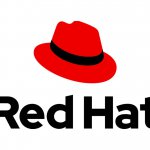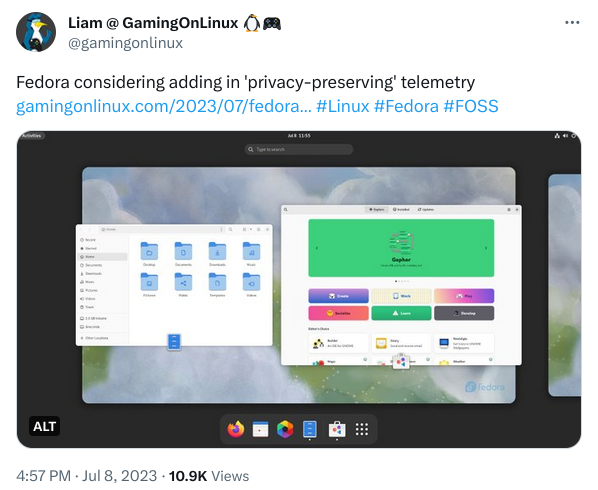
|
Getting your Trinity Audio player ready...
|
-
- Question: how can the proposal of a small addition to a minority desktop operating system cement a seismic shift in how the world runs?
- Answer: when it’s Red Hat doing the announcing.
Red Hat’s proposal of the addition of telemetry in next year’s Fedora Workstation 40 is the latest in a line of decisions from the last two years that are slowly but surely ostracizing its core users. The community of IT professionals that runs Red Hat Enterprise Linux, Fedora, and previously, CentOS, has had to endure what objectively has been a long-term assault on the company’s open-source roots and ethos.
Long-term implications
With a significant market share of enterprise server software and services, Red Hat stands to lose out in the long term a cost directly attributable to short-term financial decisions that stem – the open-source community would like to believe – from its paymasters in IBM.
When Red Hat was acquired by Big Blue back in 2019 for $34bn, Red Hat’s CEO Jim Whitehurst said, “We think open source has become the de facto standard in technology because it enables […] solutions. Joining forces with IBM gives Red Hat the opportunity to bring more open source innovation to an even broader range of organizations and will enable us to scale to meet the need for hybrid cloud solutions that deliver true choice and agility.”
And initially, IBM seemed happy enough to keep the poster child of monetizing open-source successfully ticking along as previously. The business model that continued to prove successful (pre-tax income in 2020, for instance, was $14.3 bn) was the distribution of software freely but charging for support and maintenance.

Netherlands-4425 – David and Goliath” by archer10 (Dennis) is licensed under CC BY-SA 2.0.
Monetizing open-source
Many open-source software companies have followed Red Hat’s lead, using service contracts and/or paid-for extra features to generate income, money that could be spent, for example, paying the developers that often wrote the initial software versions. Income generated in this way also funds infrastructure, marketing, customer support services, and so on – all the trappings, in fact, of the modern business. There are literally thousands of projects that have become profitable concerns while simultaneously distributing their wares freely.
And few areas of modern life are not touched by what is, in many cases, this profitable yet circular economic model. Databases, cybersecurity features, web services, e-commerce, project management, smart cities, music, CGI, broadcast media, streaming – you name it, and without exception, open-source code and ethos are there, in varying degrees of background. FOSS (free and open-source software) runs much of the world and its electronic infrastructure.
While it seems anathematic that something free to use can and does make money, the concept is simple enough: by letting others access code, a project benefits from feedback and additions from many thousands, if not millions, of users and contributors. Code and improvements on that code are shared around, with every new feature enjoyed by all. Benefits and new features come from the users, the project maintainers, or, more often, both.
The licensing weeds
Red Hat Enterprise Linux’s license was and remains based on the GPL (General Public License) that stipulates “copyleft”: anyone running RHEL gets unhindered access to the source code, so they can a) see what they’re running and b) are bound to distribute any improvements or bug fixes so that all users benefit.
Red Hat pioneered the commercialization of its products under the GPL, thereby successfully staying true to its original model of distributing source code and reaping the benefits. It soon became the provider of a stable, reliable, enterprise-grade set of software products on which companies could base their entire operations. And to sleep soundly each night, companies and organizations worldwide paid for a license for RHEL Red Hat Enterprise Linux) in the form of a subscription to ensure that situation continued. The last thing any business wants, after all, is unpredictability. When business-critical systems go wrong, the folk who distrinute and maintain them are at the end of the phone. It’s simple and provably effective.
But in the last two years, however, Red Hat has started changing its operating model in favor of revised practices that are dismaying many users.
Rolling back the (spirit of the) GPL
Thanks to the source code’s availability (source code is the human-readable text that can be compiled and run by anyone), several Red Hat Enterprise Linux versions sprung up that were (and remain) byte-for-byte copies. The best-known of these was CentOS. Red Hat decided to buy the project back in 2014 by bringing its maintainers in-house and paying them a salary. Its reasoning at the time was to ensure that this well-known clone didn’t besmirch the name of its originating project, RHEL.
The company accepted that many users would develop products on CentOS, safe knowing that their products would run on full-fat RHEL. When the time came to run these offerings as critical services, the companies developing products would switch to RHEL (at least, on their production servers) to ensure support, reliability, security, and uptime. CentOS was, in effect, an on-ramp to a RHEL license.
Naturally, issues and bugs discovered in CentOS were reported to CentOS and, therefore, upsrtream to Red Hat, distributing knowledge and improvements among all users of paid-for RHEL and support-less yet free CentOS.
However, in 2022, Red Hat decided that CentOS was not “bringing value” to RHEL and changed the nature of the distribution it now controlled, renaming it CentOS Stream and changing its purpose. Instead of a bug-for-bug copy of RHEL, CentOS Stream became a testing distribution where the next features to land in RHEL could be beta-tested by its users. Those wishing to run systems in a project’s development and testing stages would therefore be more minded to run RHEL and pay for licenses according to the number of machines the OS was hosted on.
YOU MIGHT LIKE

RHEL 9’s Release Indicates a Turning Point for Red Hat
At a stroke, Red Hat lost a valuable body of contributors, who were now unable to give feedback to Red Hat on its core, stable, fit-for-production project, RHEL. While some software houses did purchase licenses for their pre-production systems previously running CentOS, many jumped ship, either to different implementations of Linux (such as Debian) or to one of the other bug-for-bug clones of RHEL that quickly gained popularity.
Big money talks
Of course, Red Hat’s decision to stop offering CentOS was within its rights. It’s easy to see why the decision was made: there was a phalanx of users that was effectively using RHEL in the form of CentOS and not paying Red Hat a cent. By forcing the issue, licensing income would rise. The logic stumbles, however: instead of lots of active users of two in-house products, each helping to improve those products, Red Hat now effectively reduced its developer headcount to a number comprising RHEL license-payers plus in-house developers at Red Hat. The community’s input stemming from those running CentOS was lost.
It’s arguable whether RHEL’s quality will suffer in the long-term. What’s beyond doubt is the annoyance of many thousands of users whose contributions to the quality of RHEL (via daily stress-testing the OS in the form of CentOS) were sidelined.
The company’s next move in June 2023 was to attempt to limit access to the RHEL source code to those who have bought a RHEL license. Under the GPL, any user of software with a GPL license has the right to its source code and to redistribute that source code. Under Red Hat’s new terms, paying customers redistributing that source code will lose their support from Red Hat, and the company will not do business with the customer again.
While that move is within the letter of the GPL, it’s certainly not following its spirit. Those who break the Red Hat terms by exercising their right to redistribute the source code will lose that assurance that keeps mission-critical services running smoothly. Supported, maintained software, or the GPL: it’s your choice.

Source: Twitter
That move left two well-known bug-for-bug duplicates of RHEL – Alma Linux and Rocky Linux – in a difficult situation. By copying RHEL source code minus branding, they would be in breach of Red Hat’s terms and, therefore, subject to legal redress. And IBM has more than a few lawyers at its disposal, certainly more than the teams at Alma & Rocky can afford. Arguing the terms and spirit of the GNU Public License would tie up millions of dollars in an avaricious legal system, money that smaller outfits don’t have.
Red Hat has therefore closed off what could be seen as another loophole via which ungrateful users were running “its” software for “free.” This makes perfect economic sense in an arena of pure capitalism, where a company controls its proprietary code and charges money for it. However, RHEL, like every other Linux-based operating system (such as Android, for example), comprises many thousands of open-source components, many of which it had little to do with. Not least among those components is the freely-distribute-able Linux kernel. However, the voice of such counter-arguments is lost in the noise of lawyers’ bills fluttering in the breeze.
Rolling back on a business model that’s proven to have worked for Red Hat and its thousands of imitators for the sake of short-term growth in sales is stupid. It exhibits, at best, ignorance of how the software that runs the world has been created. It would be worse if the knowledge were there and was being ignored for the sake of short-term liquidity and stockholder dividends.
The open-source business model of freely-distributable with optional paid-for services works. In fact, it worked so well that Red Hat was an attractive proposition, financially, for IBM. Now the company is burning its bridges with the community of users that built the platform, and it thinks that’s OK.
Display Systems Team’s missteps
Red Hat-backed bleeding-edge Linux distribution Fedora is the latest of the company’s projects to announce what will be a deeply unpopular move with that community. Fedora Workstation 40 will use a telemetry code snippet to report to Red Hat usage metrics as of April 2024.
Telemetry is a contentious issue in the privacy-focused world of open-source and Linux. After all, even anonymized data can be paired with other information sources to de-anonymize it. Data science is partly the practise of coloring-in data pictures to get clearer insights, something that the technologically-savvy audience of Fedora users knows only too well.
The latest Red Hat mis-step comes from the Display Systems Team that recently announced it would cease to maintain LibreOffice (an enterprise desktop staple) in favor of more interesting (and presumably more valuable) work in Wayland, an alternative display manager, among other less resource-heavy, pickable cherries.
Conclusions
Big Blue is an old company that has successfully transformed itself over many generations. When it acquired Red Hat, it was thought that some of the modern software and open-source magic would rub off on IBM, revitalizing the behemoth and remolding it to stay fit for decades to come. Recent turns of events, including several conservative choices of CEO at IBM, point to Blue’s priority to service debt and pay shareholders quickly.
Short-term liquidity may look good when high-up executives negotiate their target-dependent annual bonuses. But if hitting KPIs is at the cost of the long-term demise of the standard-bearer for open-source monetization, then who really cares?









